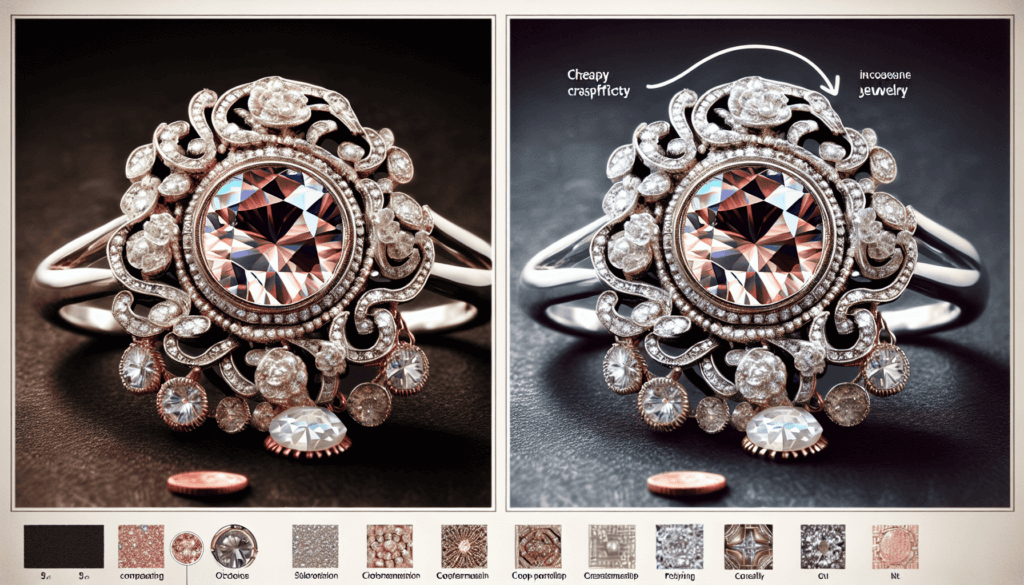Are you tired of wasting your hard-earned money on cheap and low-quality jewelry? Look no further! In this article, you will discover some foolproof tips and tricks to help you discern between genuine, high-quality jewelry and its cheap imitations. From examining the metal and gemstones to understanding craftsmanship, we will equip you with the knowledge to make informed decisions when shopping for jewelry. Say goodbye to disappointing purchases and hello to beautiful, long-lasting pieces that will truly elevate your personal style.

Understanding the Definitions
Defining cheap jewelry
Cheap jewelry refers to pieces that are made with low-cost materials and have a lower price point compared to high-quality jewelry. These pieces may be mass-produced and often lack the durability, craftsmanship, and longevity found in higher-end jewelry. They are typically made with inexpensive metals, imitation gemstones, and synthetic materials.
Defining high-quality jewelry
High-quality jewelry is crafted with superior materials, exceptional craftsmanship, and attention to detail. These pieces are often made with precious metals like gold, platinum, and sterling silver, and incorporate genuine gemstones that have been ethically sourced. High-quality jewelry is built to last, offering timeless beauty, durability, and value.
Defining costume jewelry
Costume jewelry, also known as fashion or statement jewelry, is not made with precious metals or genuine gemstones. Instead, it is designed to be affordable and stylish, featuring various materials such as base metals, glass, plastic, or acrylic stones. Costume jewelry allows you to experiment with trends and enhance your outfits without making a significant investment.
Difference between cheap and high-quality jewelry
The main difference between cheap jewelry and high-quality jewelry lies in the materials used, the craftsmanship employed, and the overall value and longevity of the pieces. Cheap jewelry often uses cheaper metals, synthetic gemstones, and lacks the attention to detail found in high-quality pieces. In contrast, high-quality jewelry utilizes precious metals, genuine gemstones, and is crafted with skill and expertise, resulting in a more enduring and valuable piece of jewelry.
Identifying Cheap Metals
Recognizing common cheap metals
Cheap jewelry frequently incorporates inexpensive metals such as nickel, brass, and zinc. These metals are readily available and offer a lower production cost compared to precious metals like gold and silver. Since cheap metals lack the durability and longevity of their precious counterparts, they tend to tarnish, corrode, or break down over time.
Effects of cheap metals on the skin
Wearing jewelry made with cheap metals can have various effects on the skin, especially for individuals with metal sensitivities or allergies. Cheap metals like nickel are known to cause allergic reactions, resulting in redness, itching, and even dermatitis. This can be uncomfortable and may discourage you from wearing certain pieces of jewelry.
Physical characteristics of cheap metals
Cheap metals often possess distinct physical characteristics that can help identify them. Nickel, for example, has a shiny, silver appearance and may develop a yellowish hue when exposed to air or moisture. Brass tends to have a yellowish tint, while zinc can be recognized by its bluish color. These metals may also feel lightweight, flimsy, or less substantial compared to high-quality metals.

Recognizing Quality Marks
Understanding jewelry quality marks
Jewelry quality marks, also known as hallmarks, are stamps or engravings placed on jewelry pieces to indicate the purity, composition, and authenticity of the materials used. These marks provide valuable information about the jewelry’s quality and can help determine if a piece is made with high-quality materials or not.
Identifying common quality marks on gold jewelry
Gold jewelry is often marked with a karat stamp to indicate its purity. Common quality marks for gold jewelry include 24K, 18K, 14K, and 10K, with 24K being the purest form of gold. These marks indicate the percentage of gold content in the piece, with higher karat numbers signifying a higher amount of gold and, therefore, higher quality.
Identifying common quality marks on silver jewelry
Silver jewelry is typically marked with a numerical value or the term “sterling” to indicate its quality. Sterling silver, for example, is marked with “925,” meaning it contains 92.5% pure silver. Other quality marks for silver jewelry may include “800,” “835,” or “999,” each representing a different silver content percentage.
Checking for Craftsmanship
Evaluating the jewelry’s craftsmanship
Craftsmanship plays a crucial role in determining the quality of jewelry. When assessing a piece, pay attention to the details and precision of the design. High-quality jewelry is meticulously crafted, with smooth edges, secure settings for gemstones, and no visible flaws or imperfections. The clasps, hinges, and closures should be sturdy and well-constructed.
Signs of poor craftsmanship
Poorly crafted jewelry often exhibits signs of subpar workmanship. Look for rough edges, inconsistent soldering, or uneven settings for gemstones. Loose or wobbly stones, visible glue residue, or poorly aligned closures are also indicators of poor craftsmanship. These flaws not only affect the aesthetic appeal of the jewelry but also compromise its durability and overall quality.

Observing the Gemstones
Distinguishing real from fake gemstones
Identifying genuine gemstones can be challenging, especially with the availability of convincing synthetic or imitation stones. One reliable method is to examine the gemstone under magnification to look for natural characteristics such as inclusions, color variations, or growth patterns. Additionally, genuine gemstones tend to be colder to the touch compared to their imitation counterparts.
Physical characteristics of cheap gemstones
Cheap gemstones are often made from glass, plastic, or low-grade synthetic materials. They may lack the brilliance, clarity, and depth of color found in genuine gemstones. Cheap gemstones may appear cloudy, have visible bubbles or scratches, and lack the vibrant hues associated with high-quality gemstones.
Looking for Irregularities
Visible signs of poor jewelry construction
Inspecting a piece of jewelry for visible signs of poor construction is essential in determining its quality. Look for loose or missing prongs, uneven stone settings, or misaligned components. Additionally, examine the overall symmetry and balance of the piece. High-quality jewelry will have consistent and precise construction, while cheap jewelry may exhibit irregularities in design or assembly.
Common irregularities in cheap jewelry
Cheap jewelry often displays various irregularities that can give away its low quality. These irregularities may include uneven plating or coloring on metal surfaces, visible seams or gaps in the construction, or poorly executed soldering. Lack of attention to detail and rushed manufacturing processes are often evident in cheap jewelry, distinguishing it from its higher-quality counterparts.

Weighing the Jewelry
Importance of weight in determining jewelry quality
The weight of a piece of jewelry can provide valuable insights into its quality and value. Precious metals, such as gold and silver, have higher densities than cheap metals, resulting in a heavier weight. High-quality jewelry tends to feel substantial when held, indicating the use of solid, durable materials rather than lightweight or hollow components.
Comprehending the weight differences between cheap and high-quality jewelry
Cheap jewelry made with base metals or filled with lightweight materials may feel noticeably lighter in comparison to high-quality jewelry. Gold and silver pieces, on the other hand, have a satisfying weight and density that is characteristic of their value. By gauging the weight of a piece, you can often discern its quality and authenticity.
Testing the Jewelry
Easy home tests to check jewelry quality
Several simple tests can be conducted at home to assess the quality of jewelry. One common test is the magnet test, where a magnet is passed over the piece to check for any attraction. Genuine gold and silver are not magnetic, while cheap metals may exhibit magnetic properties. Another popular test involves using a jewelry testing solution to determine the purity of gold or silver.
Professional testing options
For a more accurate assessment, professional testing options are available. X-ray fluorescence (XRF) spectrometry is a non-destructive method commonly used to determine the composition of metals in jewelry. This method can identify the purity of precious metals and verify gemstones. Additionally, professional jewelers can provide expert opinions and evaluations based on their experience and expertise.

Consulting a Professional
Role of professional jewelers in identifying cheap jewelry
Professional jewelers play a crucial role in identifying and evaluating the quality of jewelry. With their knowledge and expertise, they can determine the authenticity of gemstones, assess the craftsmanship, and identify any potential flaws or irregularities. Jewelers can also help determine the value of a piece and provide guidance on purchasing high-quality, reputable jewelry.
Steps to find and consult a reputable jeweler
When seeking the advice of a professional jeweler, it is important to find a reputable, trustworthy individual or establishment. Start by researching local jewelers or getting recommendations from friends or family. Look for certifications, memberships in professional organizations, or positive reviews as indications of their reputation. Schedule a consultation with the jeweler to discuss your concerns and questions regarding the quality of jewelry.
Buying from Reputable Sources
Identifying reputable jewelry sellers
To ensure you are purchasing high-quality jewelry, it is essential to buy from reputable and trustworthy sources. Reputable jewelry sellers are often established brands, reputable jewelers, or authorized dealers. They offer a wide selection of authentic, well-crafted pieces and are transparent about the materials used. Look for online reviews, certifications, and guarantees to verify a seller’s reputation.
Red flags to look for when buying jewelry
When purchasing jewelry, be cautious of certain red flags that may suggest low-quality or counterfeit pieces. Unbelievably low prices that seem too good to be true often indicate the use of cheap materials or imitation gemstones. Be wary of sellers who provide vague or misleading information about the jewelry’s composition, origin, or quality. Limited return policies, lack of proper packaging or documentation, and pressure to make an immediate purchase are also warning signs to watch out for.
Consumer protection in jewelry purchasing
Consumer protection laws and regulations exist to safeguard buyers from unscrupulous practices and ensure fair trade in the jewelry industry. When making a jewelry purchase, be aware of your rights as a consumer. Familiarize yourself with refund and return policies, warranties, and guarantees provided by the seller. In case of any disputes or concerns, document your transactions and seek resolution through appropriate channels, such as consumer protection agencies or legal avenues.
By understanding the definitions, identifying cheap metals, recognizing quality marks, checking for craftsmanship, observing gemstones, looking for irregularities, weighing the jewelry, testing it, consulting professionals, and buying from reputable sources, you can confidently navigate the world of jewelry and make informed choices when purchasing quality pieces. Remember, investing in high-quality jewelry not only enhances your style and appearance but also ensures that your treasured pieces will endure the test of time.



